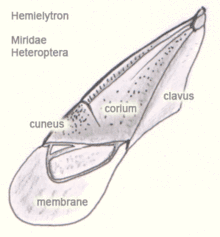Miridae
The Miridae are a large and diverse insect family at one time known by the taxonomic synonym Capsidae.[1] Species in the family may be referred to as capsid bugs or "mirid bugs". Common names include plant bugs, leaf bugs, and grass bugs. It is the largest family of true bugs belonging to the suborder Heteroptera; it includes over 10,000 known species, and new ones are being described constantly. Most widely known mirids are species that are notorious agricultural pests that pierce plant tissues, feed on the sap, and sometimes transmit viral plant diseases. Some species however, are predatory.
| Miridae | |
|---|---|
 | |
| Rhabdomiris striatellus | |
| Scientific classification | |
| Kingdom: | Animalia |
| Phylum: | Arthropoda |
| Class: | Insecta |
| Order: | Hemiptera |
| Superfamily: | Miroidea |
| Family: | Miridae Hahn, 1831 |
| Genera | |
|
Over 1,300 including: | |
Description
.jpg.webp)

Miridae are small, terrestrial insects, usually oval-shaped or elongate and measuring less than 12 millimetres (0.5 in) in length. Many of them have a hunched look, because of the shape of the prothorax, which carries the head bent down. Some are brightly coloured and attractively patterned, others drab or dark, most being inconspicuous. Some genera are ant mimics at certain stages of life. The Miridae do not have any ocelli. Their rostrum has four segments. One useful feature in identifying members of the family is the presence of a cuneus; it is the triangular tip of the corium, the firm, horny part of the forewing, the hemelytron. The cuneus is visible in nearly all Miridae, and only in a few other Hemiptera, notably the family Anthocoridae, which are not much like the Miridae in other ways. The tarsi almost always have three segments.[2]
Some mirid species
- Lygus bugs (Lygus spp.), including the tarnished and western tarnished plant bugs, are serious pests in the cotton, strawberry, and alfalfa industries.
- Stenotus binotatus, a minor pest of cereal crops, especially wheat
- Apple dimpling bug (Campylomma liebknechti) damages apple blossoms and small growing fruits.
- Mosquito bugs Helopeltis and Afropeltis spp. – that infest various crops including tea, cacao and cotton
- Honeylocust plant bug (Diaphnocoris chlorionis) damages foliage on honeylocust trees.
- Green mirid (Creontiades dilutus) damages many types of field crops.
- Potato mirid (Calocoris norvegicus) is a noted pest of potato and clover plants in New Zealand.
- Deraeocoris nebulosus prefers other insects to plants in its diet, and has been used as a biocontrol agent against mites and scale insects.
- Dicyphus hesperus sucks sap from various plants and preys on whitefly and red spider mites and can be used in biological pest control.[3]
Systematics
This family includes a large number of species, many of which are still unknown, distributed in more than 1300 genera. The taxonomic tree is divided into the following seven subfamilies and numerous tribes:
- Bryocorinae
- Bryocorini
- Dicyphini
- Eccritotarsini
- Cylapinae
- Cylapini
- Fulviini
- Deraeocorinae[4]
- Clivinematini
- Deraeocorini
- Hyaliodini
- Saturniomirini
- Surinamellini
- Termatophylini
- Isometopinae
- Diphlebini
- Isometopini
- Mirinae
- Herdoniini
- Hyalopeplini
- Mirini
- Pithanini
- Restheniini
- Stenodemini
- Orthotylinae
- Phylinae
- Hallodapini
- Leucophoropterini
- Phylini
- Pilophorini
- Genera Incertae sedis: Adenostomocoris, Arctostaphylocoris, Aurantiocoris, Calidroides, Chlamyopsallus, Guentherocoris, Neopsallus, Pruneocoris, Vanduzeephylus
References
- Henry, T. J. and A. G. Wheeler, Jr., 1988A. Family Miridae Hahn, 1833 (= Capsidae Burmeister, 1835). The plant bugs, pp. 251--507. In: Henry, T. J. and R. C. Froeschner (eds.), Catalog of the Heteroptera, or True Bugs of Canada and the Continental United States. E. J. Brill, Leiden.
- Richards, O. W.; Davies, R.G. (1977). Imms' General Textbook of Entomology: Volume 1: Structure, Physiology and Development Volume 2: Classification and Biology. Berlin: Springer. ISBN 0-412-61390-5.
- McGregor, Robert R.; Gillespie, David R.; Quiring, Donald M.J.; Foisy, Mitch R.J. (1999). "Potential Use of Dicyphus hesperus Knight (Heteroptera: Miridae) for Biological Control of Pests of Greenhouse Tomatoes". Biological Control. 16 (1): 104–110. doi:10.1006/bcon.1999.0743.
- Junggon, Kim; Hong, Ki Min; Woon, Kee Paek; Sunghoon, Jung (2017). "Two new records of the subfamily Deraeocorinae (Hemiptera: Heteroptera: Miridae) from the Korean Peninsula". Journal of Asia-Pacific Biodiversity. 10 (3). doi:10.1016/j.japb.2017.05.001.
Further reading
- Cassis, G.; Schuh, R. T. (2012). "Systematics, Biodiversity, Biogeography, and Host Associations of the Miridae (Insecta: Hemiptera: Heteroptera: Cimicomorpha)". Annual Review of Entomology. 57: 377–404. doi:10.1146/annurev-ento-121510-133533. PMID 22149267.
- Wheeler, Alfred George, Jr. (2001). Biology of the plant bugs (Hemiptera: Miridae), pests, predators, opportunists. Ithaca, New York: Cornell University Press. ISBN 978-0-8014-3827-1.CS1 maint: multiple names: authors list (link) Google books preview
External links
| Wikimedia Commons has media related to Miridae. |
| Wikispecies has information related to Miridae. |
